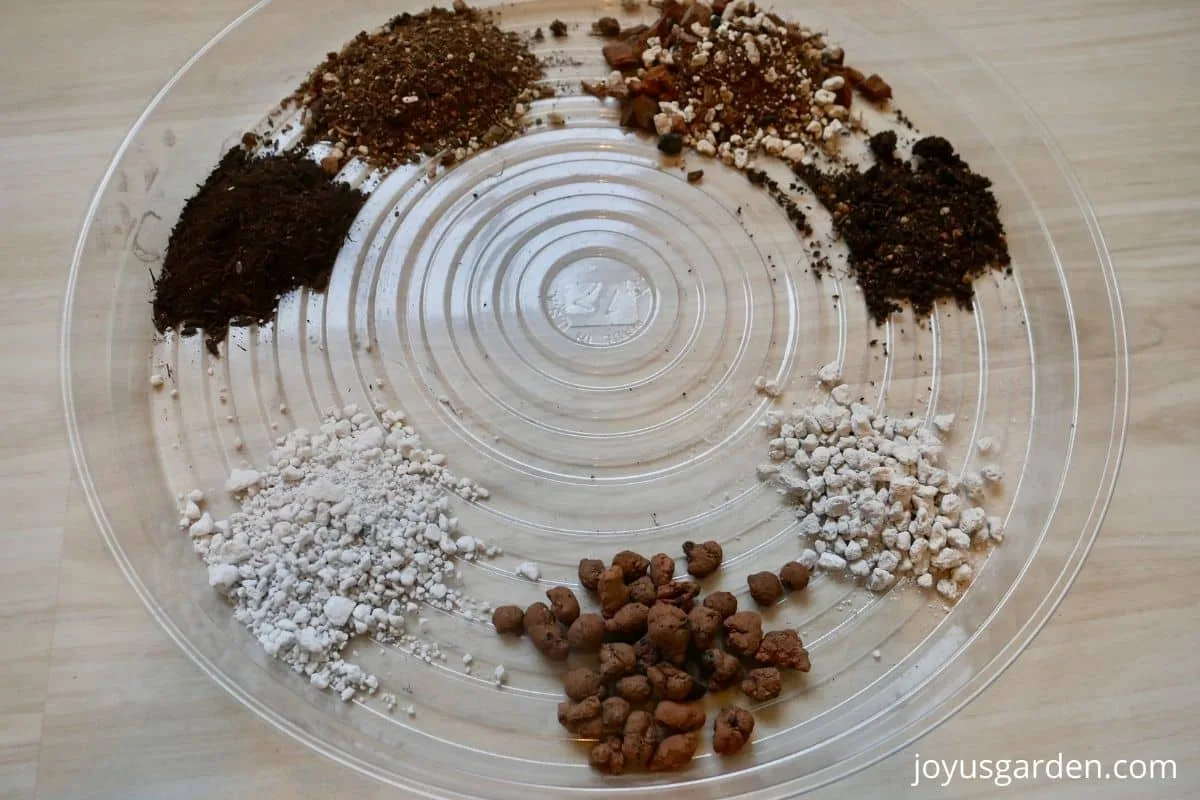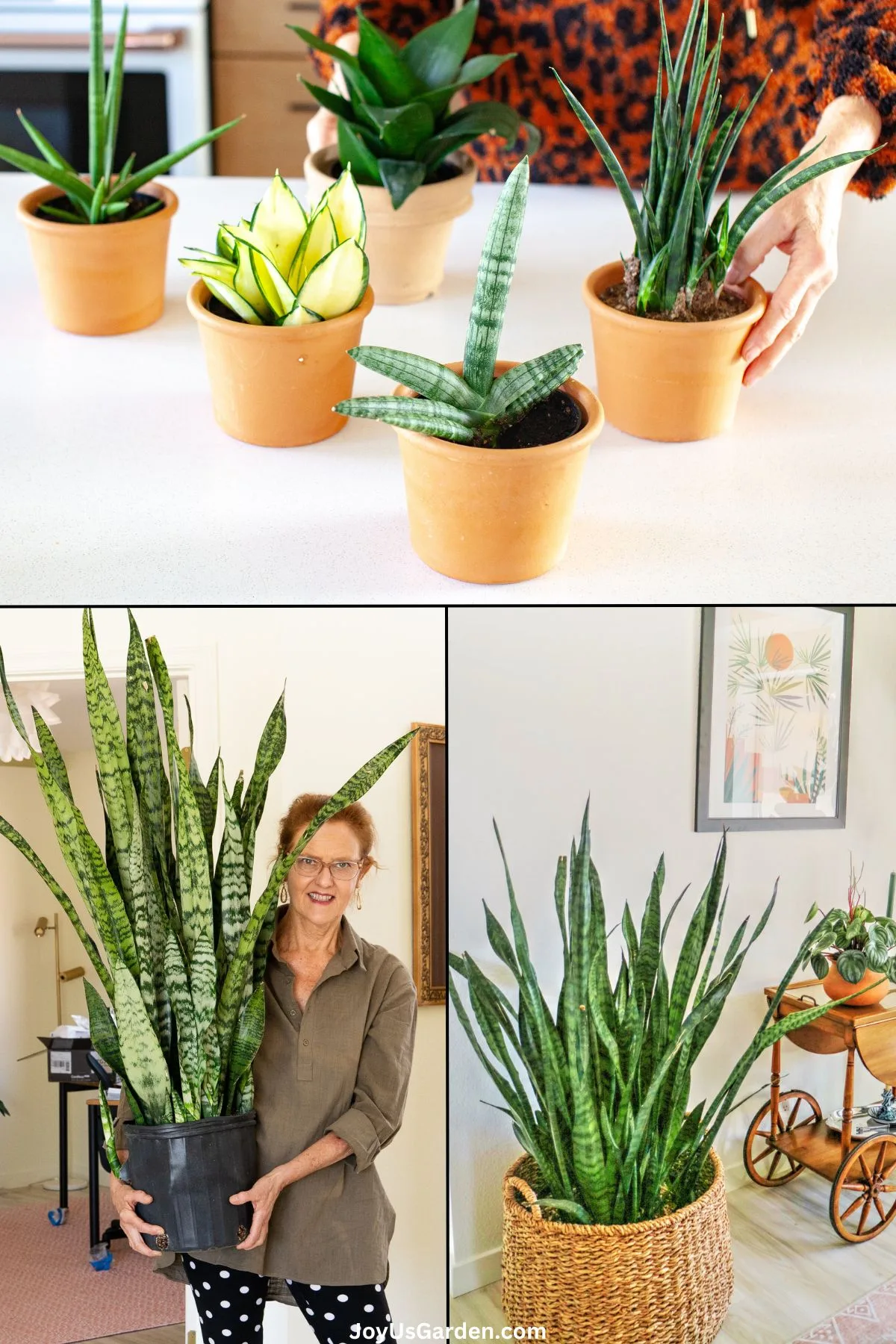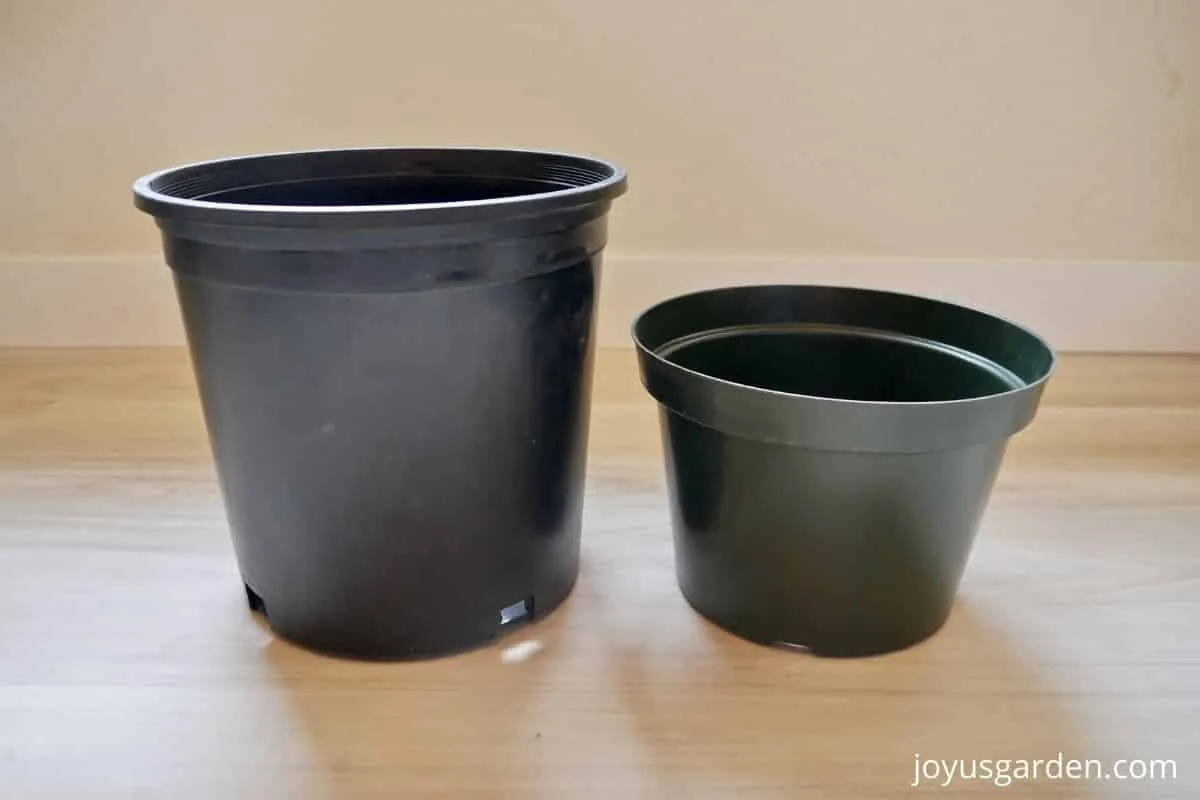Repotting Snake Plants: The Mix To Use & How To Do It
Like all other plants, repotting Snake Plants is essential for ensuring their health and vitality. In this guide, I’ll explain the steps, the best soil mix to use, the ideal time to repot your Snake Plant, aftercare, and answer FAQs.
I love Snake Plants and have several thriving indoors and outdoors at my Arizona desert home. Their spiky, patterned foliage is fascinating. Plus, they’re low-maintenance and thrive with minimal attention!
Note: This post was published in 2017. It was updated on 1/28/2021 & again on 7/11/2024.
What are Snake Plants?
Snake Plants are among the most popular houseplants worldwide due to their resilience and spiky architectural look. Despite being tropical plants, they thrive in dry air and lower to moderate light conditions. With numerous species and varieties available, you can find Snake Plants in various sizes, forms, and leaf variegations.
Botanic Name: Dracaena (formerly Sansevieria) spp Common Names: Snake Plant, Mother-In-Law’s Tongue, Snake’s Tongue Plant
When is the Best Time to Repot Snake Plants
The best time is during the growing season, which is early spring through early fall, depending on your zone. Snake Plants don’t mind being potbound, so there is no need to repot yours unless it’s showing signs of stress or outgrowing the pot. Mature Snake Plants have strong roots and can split open grow pots.
Best Potting Soil for Snake Plants
At some point, your plant will appreciate a fresh soil mix. Snake Plants prefer to be kept dry, so the mix they’re planted in must drain freely. You don’t want it to hold too much water, which can lead to root rot.
That’s why I add the succulent and cactus mix to the recipe below: It’s chunky, well-aerated, and yields good drainage. I also toss in a few handfuls of organic compost as I’m planting and a 1/2″ layer topping of the worm compost. Both of these add nourishment and break down slowly.
The Soil Mix “Recipe” I Use
2/3 Potting Soil.
I alternate between Happy Frog and Ocean Forest, and sometimes, I combine them. Both are full of high-quality ingredients. Make sure the potting soil you use says it’s formulated for indoor plants on the bag.
1/3 Succulent & Cactus Mix.
I use this DIY succulent and cactus mix (this has coco chips in it) for added drainage. If you prefer a store-bought mix, this post on Succulent Soil has good options for you.
Compost.
A couple of handfuls of organic compost (more or less depending on the size of the plant).I use a local compost. This, like worm compost, enriches the soil naturally.
Worm Compost.
Worm compost is my favorite amendment, but I use it sparingly because it’s rich. You can learn more about why I use worm compost here.
The mix I used for my 5′ Snake Plant differed slightly because it went into a large 18″ pot. You can read about that Here.
Three alternate mixes that provide a fast-draining soil:
- 2/3 potting soil, 1/3 or perlite
- or 2/3 potting soil, 1/3 pumice
- or 2/3 potting soil, 1/3 clay pebbles
The pumice, perlite, and clay pebbles increase the drainage factor, enable aeration, and help prevent the soil from getting too wet.
If you’re interested in any of the above materials, you can find more details and links to buy them in Best Soil For Indoor Plants.

What Size Pot Should I Use?
They prefer to grow slightly tight in their pots. When I repot a Snake Plant, I go up one pot size. For instance, if yours is in a 6″ grow pot, then an 8″ pot would be the size you’d want to use.
Here’s an exception. When I repotted my 6′ Snake Plant, it was in a 10″ grow pot, and I repotted it into an 18″ grow pot. I used this larger pot because it was proportionate to the size of the plant
Because Sansevierias like to spread out as they grow, I’ve found that they don’t need a deep pot. A deep pot has more soil mass at the bottom, which could lead to water retention, which leads to root rot.
Whatever size you use, make sure the bottom of the pot has drainage holes so the excess water can readily flow out.

Repotting Snake Plants, Step By Step
Good to know: A Snake Plant’s roots are tough, so you don’t have to be too precious when handling the rootball.
Gather your soil mix materials. Sometimes, I mix them up ahead, and other times, I mix them in the pot as I go along.
Loosen the plant from its current pot. If the rootball is stubborn and not readily coming out, I either gently press on the grow pot or run a dull knife around the perimeter. Both ways are clearly shown in the video.
Once the entire plant is out of the pot, measure how much soil mix you’ll need to raise the top of the root ball to about 1/2″ above the rim of the new pot. The weight of the plant will eventually pull it down in the light mix. Then, add the new soil mix.
Place the plant in the pot and fill in around the sides with the mix.
Top with a thin layer of worm compost and/or compost.
This guide outlines Snake Plant Care and will help if you’re a beginning gardener.

Can Snake Plants Be Divided?
Yes, I’ve successfully divided numerous Snake Plants. Their root balls are quite resilient. For larger plants, I use a sharp knife to split the root ball into the desired number of segments.
Snake Plant Care After Repotting
After the repotting process, I place the Snake Plants back in their original growing spot. They thrive in indirect sunlight, so keeping them away from hot, sunny windows that could scorch their leaves is important.
Snake Plants are succulents, which means they prefer dry conditions. To help them adjust after repotting, I refrain from watering for about 5 to 7 days. This dry period allows their roots to settle and prevents any potential rot.
Once they’ve had time to acclimate, I resume their regular watering schedule, ensuring they remain healthy.
Do Snake Plants need to be repotted? How Often Should You Repot Snake Plants?
Snake Plants don’t mind being tight in their pots. They actually do better if the root system is a bit pot-bound. I’ve seen quite a few root-bound plants actually break their grow pots, and they’re growing just fine. Of course, a bigger pot would be appreciated!
I have a few Snake Plants I haven’t repotted for over five years. Don’t rush to repot yours unless it looks stressed or has cracked the grow pot.

Repotting Snake Plants Video Guide
Repotting Snake Plant FAQs
Houseplants appreciate fresh soil at some point. Snake Plants like a chunky soil mix that drains freely and is well aerated. They store water in their rhizomes and thick leaves, so you don’t want the soil to stay consistently wet. I always use potting soil combined with succulent potting mix.
I wouldn’t recommend using straight potting soil because it could be too heavy and hold too much water. You want to use a well-draining soil mix. Add pumice, perlite, or pebbles to up the ante on drainage and aeration. See the “Soil” section for more details on these amendments.
If the grow pot is cracked, that’s one sign it needs repotting. Generally, I repot my Snake Plants every 4-6 years.
Snake Plants do fine growing tight in their pots. At some point, they’ll appreciate a bigger pot, which gives the rhizomes more room to spread.
No. Their rhizomes spread out rather than grow deep. A deep pot means more soil mass, which can cause the root ball to stay too wet.
Some, like the Bird’s Nest varieties, do just fine in smaller pots. As the taller species and varieties grow, they’ll need larger pots.
When repotting a snake plant, a general rule of thumb is to go up one pot size to avoid an excess of soil mass. I often use azalea pots because they have a lower profile and provide better drainage.

Conclusion: If you’re new to houseplant gardening, repotting Snake Plants might seem daunting, but with the right approach, it’s a straightforward process that can invigorate your plants and encourage healthy growth. Your Snake Plants will thrive in their new pots if you follow these steps and pay attention to their sunlight and watering needs.
Happy gardening!

Our No-Nonsense Indoor Plant Care Guide
Even if you’re a serial plant killer, this ebook aims to turn your brown thumb green! Get a multitude of practical plant care tips. Some of the 33 plants included in this book are Pothos, Agalonema, Spider Plant, Kentia Palm, a variety of Dracaenas, some succulents, plus many more.
This post may contain affiliate links, you can read our policies here.
- About the Author
- Latest Posts
Nell, the founder of Joy Us garden, was born into a gardening family and grew up in Connecticut’s countryside. After living in Boston, New York, San Francisco, & Santa Barbara, she now calls the Arizona desert home. She studied horticulture & garden design, working in the field all her life. Nell is a gardener, designer, blogger, Youtube creator, & author. She’s been gardening for a very long time & wants to share what she’s learned with you.











Either would work fine Maxine – Snake Plants aren’t fussy as to what type of pot they’re grown in. They do break though grow pots over time, as you know. I used to grow them outdoors in bright shade when I lived in Santa Barbara. I currently have mine growing in 3 different types of pots & all are doing great. Nell
How long does Snake plant take to grow?, also, what is the best way to water them (eg. spray them, or straight to the soil?)
Hi! I’ve enjoyed reading over your website and watching your videos. They’ve been very helpful. I recently purchased two snake plants from Lowes that were each in a 9″ plastic pot. My goal was to combine them together to make a larger plant to use indoors. The pot I purchased has a tapered shape and is 13.5″ D at the top of the new pot (does have drainage holes). Is this too large? I thought it would be ok but when I started to repot I ran out of soil; need a few more inches at the top. It’s hanging out like that until I can get more. I didn’t water yet. The plant needs adjusted some for centering but there will still be a few inches of space around the top of the new pot. I wish I could attach a photo. Ideally I would have liked to add more leaves but when I went back for another plant they were out. I would like the plant to continue to grow upwards. There are very tall leaves in the center of each plant but the surrounding leaves were various heights starting about half the height of the tallest leaves.
Thank you!
Hi Carlo – It depends on the growing situation. Here in Tucson where it’s warm for many months, mine grow faster than they did when I lived in San Francisco which has fog & is much cooler. Although they aren’t high light plants, they grow faster with more light. Water them via the soil – they don’t need misting. Nell
Hi Alisha – Thank you! If you’re potting up sansies in 2 – 9″ pots into a 13.5″ diameter pot, they’ll do fine. They don’t mind growing tight in their pots. I’ve combined Snake Plants in various pots & they’ve all done fine. Nell
Hi Nell.
Nice website. Thanks.
2 of my favourite plants are MILT and Aloe Vera which both grow pretty good in pots in my garden here in North Thailand. The pots are sitting on soil and have holes in the bottom so drainage is good and presumably the roots are extending into the soil beneath. I haven’t lifted them so I am guessing. One of my MILT plants has been in the same medium/large pot for at least 10 years cos it was in the garden when we bought the property.
I give both the MILT and the Aloe Vera moderate water and use a small amount of wood ash for mineral replacement I don’t add anything else. They appear to be thriving well.
I tried using wood ash in combination with nitrogen fertiliser that we use on our crops on some other plants I have. Disastrous! The soil turned into an Ammonium factory that I could have sold to Monsanto!
I also have Lucky Bamboo in vertical sided drinking glasses on the table on my verandah. No soil, no pebbles. They get early morning direct sunlight. The rest of the day they are in shade. But UV radiation remains high all day. I just give them a refill of oxygenated water every few days. Nothing else.
Seems to be working. No algae, and the roots are clearly growing.
I also have a cactus which is now 7 foot tall having grown it from a straggling root 4 years ago. He lives
in a medium sized pot with a hole in the bottom resting on soil.
Any advice on looking after Aloe Vera ( which looks like a cactus but isn’t ) and cactuses, appreciated.
I am pretty sure North Thailand is very similar to the Arizona desert. But when it rains here we are talking a serious drenching.
Have a nice day!
Chris.
I repotted 2 snake plants into one. Some of the leaves are very pale yellow at the bottom. Did I not plant them deep enough?
Hi Jimmie – As long as the rhizomes & roots are covered, the plant is fine. Could be too much water. Nell
State of leaf determines state of root. Same for any plant. The leaf is the barometer of the health of the plant. Leaf totally dependent upon the root that feeds it.
If I see a plant in my garden with leaves that don’t look right he is either getting too much or insufficient UV, too much or insufficient minerals, or possibly toxic chemicals. If he has rot at his base it is probably down to too much irrigation. Like Nell said. If the leaves of any plant, high or low, don’t look right. you need to take corrective action immediately. If not, your plant is under threat.
I watch my cactuses, snake plants and Aloe Vera very closely here in Thailand.
Ain’t growing plants just like a Kansas Combine Harvester reaps non-GM corn.
Best US beef is grass fed. Same with free-range chicken.
If the egg has an orange yolk it is highly likely to be OK. If the yolk is yellow the hen lived in a cage and was fed whatever made economic sense for the breeder.
A pretty plant in a pot is a pretty plant in a pot. Feel good factor. I have no problem with that. We need more plants on patios and inside houses.
But an agricultural plant is a totally different kettle of fish.
That applies to herbs and spices just as it applies to Pacific Salmon and Wagyu Beef.
Nature created.
Ain’t plants beautiful?
Home grown fruit and veg not only looks pretty, they are seriously healthy if you eat them.
An oxygen producing plant inside a US home is definitely good news.
Keep planting!
Chris
{ Brit living in agricultural Thailand and a Trump supporter. }
Hi. I recently potted two Sansevieria using MiracleGro’s Moisture Control potting soil assuming it would not retain too much moisture, but as I am reading up on Sanke Plant, I am wondering if I should re-pot them in a mix of cactus soil. A MiracleGrow rep claims they should be fine. Please advise. I know Sanke Plants do not like wet feet. Thank you.